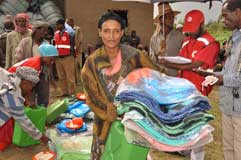Ethiopia
 With over 93 million, inhabitants Ethiopia is the most populous landlocked country in the world, as well as the second-most populated nation on the African continent.
With over 93 million, inhabitants Ethiopia is the most populous landlocked country in the world, as well as the second-most populated nation on the African continent.
Ethiopia has a long recorded history of emergencies and disasters, including epidemics, floods, landslides, earthquakes and, most commonly, drought. Every year, drought results in food insecurity for 5 to 6 million people. Seasonal flooding is another emergency that affects hundreds of thousands of people.
In addition, human, livestock and agricultural pressure on land has contributed to the degradation of the environment leading to reduced soil fertility and land productivity. A change in climatic conditions as a result of environmental degradation has proven to have a humanitarian impact on shelter, food security, access to clean water, and increased vulnerability to water-borne diseases.
With financial support from the Government of Canada, the Canadian Red Cross will be working with the Ethiopian Red Cross Society on a five-year initiative aimed at strengthening the emergency response capacities of four Red Cross National Societies in Africa. A workshop to launch the Capacity Strengthening for Emergency Response in Africa (SERA) initiative was conducted from May 6-9 , 2014 at the Ethiopian Red Cross Society’ s (ERCS) Training Center.
